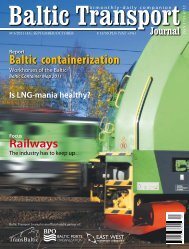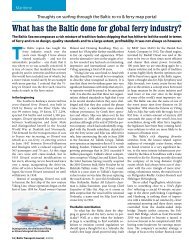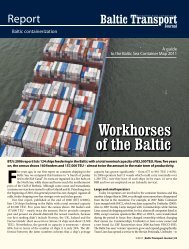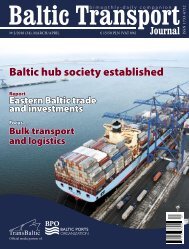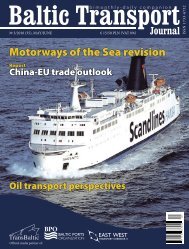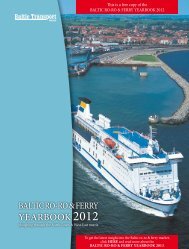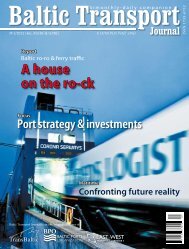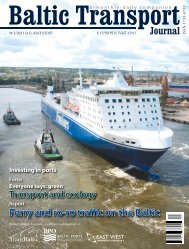Create successful ePaper yourself
Turn your PDF publications into a flip-book with our unique Google optimized e-Paper software.
for the future<br />
However, this is not the flexible MHCs, but huge ship-to-shore gantries<br />
that have truly revolutionized container handling on/off the vessels on a big<br />
scale. STS Gantries lift objects by a hoist fitted in a trolley that moves horizontally<br />
on rails. This concept is said to have been initially developed by the<br />
US-based Paceco Corporation in the 1960s (and produced by this company<br />
till now under the licensed name of Portainer). STS Gantries are now produced<br />
by many manufacturers, including the European Liebherr Container<br />
Cranes, Kalmar Industries, Konecranes, the South American IMPSA, the<br />
Chinese Zhenhua Port Machinery Company (ZPMC), and others.<br />
Liebherr offers an extensive range of STS cranes from a Panamax<br />
size to the latest generation of Megamax and Malacca-max cranes with<br />
safe working loads from 40 to 120 metric tons (4 x 20-ft. containers<br />
each weighing 30 metric tons).<br />
Container transport from quayside to stackyard<br />
Gottwald manufactures an entire fleet of Automated Guided Vehicles<br />
for automated container transport between the quay and the stack.<br />
These unmanned transporters can carry 20’, 40’ and even 45’ containers<br />
and operate under computer control using Gottwald’s own Management<br />
and Navigation Software.<br />
Also Fixed and Travelling Cargo Cranes produced by Liebherr are<br />
a good solution for installation at quaysides, in harbours and in dock-<br />
Report<br />
yards available on fixed pedestals (FCC), or on rail-mounted travelling<br />
gantries (TCC). The FCC and TCC ranges are economical, space-saving<br />
solutions for cargo handling with vessels up to the Panamax size. This<br />
relatively new concept is ideal for harbours and dockyards with limited<br />
room for manoeuvring, where low ground pressures are essential or<br />
Liebherr Fixed and Travelling Cranes offer:<br />
• a low initial outlay, economical operating<br />
and maintenance costs,<br />
• compatibility with different types of cranes to suit all<br />
cargoes and ensure maximum handling efficiency, e.g.,<br />
wire luffing, cylinder luffing, heavy-duty bulk or<br />
double-girder grab/container cranes,<br />
• the extensive range of working attachments enabling<br />
the crane to be configured for specific purposes<br />
(container or bulk handling), multi-purpose operations<br />
or special applications,<br />
• control systems with a hydraulic load sensing control<br />
(LSC) or a Liebherr Litronic® high-speed control system,<br />
• an unrestricted view of the work area and the load.<br />
where rail-mounted cranes are called for. The slewing cranes themselves<br />
are all proven designs with capacities of up to 300 metric tons.<br />
The best choice for terminals handling between 100,000 and<br />
4,000,000 TEU per year are handling systems based on straddle carries.<br />
A wide range of carrier models are offered in the market. Modern solutions<br />
contain stronger side frame for continuous twin lift operation and<br />
modular drive system with direct driven wheel hubs which ensures driver<br />
comfort in operation works and good visibility of operation space and sur-<br />
3/<strong>2008</strong> | <strong>Baltic</strong> <strong>Transport</strong> <strong>Journal</strong> | 27




